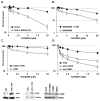YU238259 Is a Novel Inhibitor of Homology-Dependent DNA Repair That Exhibits Synthetic Lethality and Radiosensitization in Repair-Deficient Tumors
- PMID: 26116172
- PMCID: PMC4618103
- DOI: 10.1158/1541-7786.MCR-15-0036
YU238259 Is a Novel Inhibitor of Homology-Dependent DNA Repair That Exhibits Synthetic Lethality and Radiosensitization in Repair-Deficient Tumors
Abstract
Radiotherapy and DNA-damaging chemotherapy are frequently utilized in the treatment of solid tumors. Innate or acquired resistance to these therapies remains a major clinical challenge in oncology. The development of small molecules that sensitize cancers to established therapies represents an attractive approach to extending survival and quality of life in patients. Here, we demonstrate that YU238259, a member of a novel class of DNA double-strand break repair inhibitors, exhibits potent synthetic lethality in the setting of DNA damage response and DNA repair defects. YU238259 specifically inhibits homology-dependent DNA repair, but not non-homologous end-joining, in cell-based GFP reporter assays. Treatment with YU238259 is not only synergistic with ionizing radiation, etoposide, and PARP inhibition, but this synergism is heightened by BRCA2 deficiency. Further, growth of BRCA2-deficient human tumor xenografts in nude mice is significantly delayed by YU238259 treatment even in the absence of concomitant DNA-damaging therapy. The cytotoxicity of these small molecules in repair-deficient cells results from an accumulation of unresolved DNA double-strand breaks. These findings suggest that YU238259 or related small molecules may have clinical benefit to patients with advanced BRCA2-negative tumors, either as a monotherapy or as an adjuvant to radiotherapy and certain chemotherapies.
Implications: We have identified a novel series of compounds that demonstrate synthetic lethality in DNA repair-deficient cell and animal models and have strong potential for clinical translation.
©2015 American Association for Cancer Research.
Conflict of interest statement
The authors declare no conflict of interest.
Figures






References
-
- Ginsburg GS. Realizing the opportunities of genomics in health care. JAMA : the journal of the American Medical Association. 2013;309(14):1463–1464. - PubMed
-
- Leibeling D, Laspe P, Emmert S. Nucleotide excision repair and cancer. Journal of molecular histology. 2006;37(5–7):225–238. - PubMed
-
- Martin SA, Lord CJ, Ashworth A. Therapeutic targeting of the DNA mismatch repair pathway. Clinical cancer research : an official journal of the American Association for Cancer Research. 2010;16(21):5107–5113. - PubMed
Publication types
MeSH terms
Substances
Grants and funding
LinkOut - more resources
Full Text Sources
Other Literature Sources
Miscellaneous

